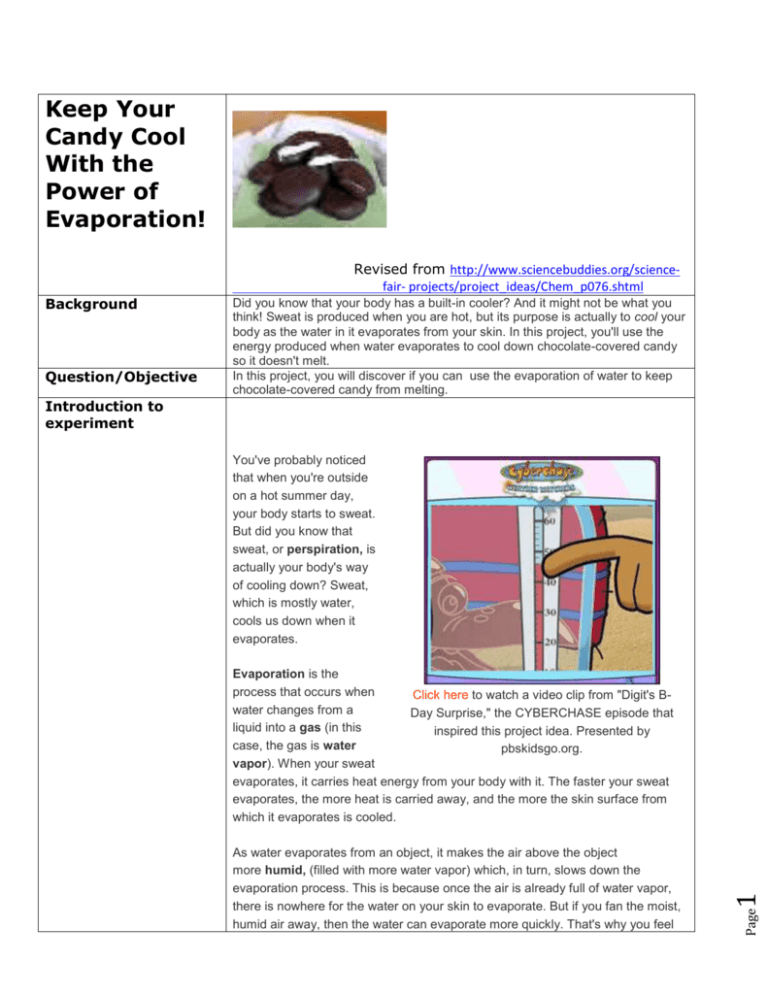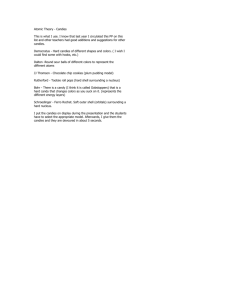Keep Your Candy Cool with the Power of Evaporation
advertisement

Keep Your Candy Cool With the Power of Evaporation! Revised from http://www.sciencebuddies.org/sciencefair- projects/project_ideas/Chem_p076.shtml Background Question/Objective Did you know that your body has a built-in cooler? And it might not be what you think! Sweat is produced when you are hot, but its purpose is actually to cool your body as the water in it evaporates from your skin. In this project, you'll use the energy produced when water evaporates to cool down chocolate-covered candy so it doesn't melt. In this project, you will discover if you can use the evaporation of water to keep chocolate-covered candy from melting. Introduction to experiment You've probably noticed that when you're outside on a hot summer day, your body starts to sweat. But did you know that sweat, or perspiration, is actually your body's way of cooling down? Sweat, which is mostly water, cools us down when it evaporates. Page As water evaporates from an object, it makes the air above the object more humid, (filled with more water vapor) which, in turn, slows down the evaporation process. This is because once the air is already full of water vapor, there is nowhere for the water on your skin to evaporate. But if you fan the moist, humid air away, then the water can evaporate more quickly. That's why you feel 1 Evaporation is the process that occurs when Click here to watch a video clip from "Digit's Bwater changes from a Day Surprise," the CYBERCHASE episode that liquid into a gas (in this inspired this project idea. Presented by case, the gas is water pbskidsgo.org. vapor). When your sweat evaporates, it carries heat energy from your body with it. The faster your sweat evaporates, the more heat is carried away, and the more the skin surface from which it evaporates is cooled. cooler if you fan yourself or if there's a gust of wind. In places with hot weather, engineers design misters—machines that spray a fine water mist—for use in public places to help people keep cool. These misters help out your body's natural sweat cooling system by providing more water to evaporate and carry away heat energy from your body. Another way that you can keep cool on a hot day is by dipping a bandana in water and wearing it around your neck. The extra water from the bandana causes more evaporation, which keeps your body even cooler than it would be with only sweat. You can apply the same process of evaporative cooling that your body uses in order to cool down objects. In the CYBERCHASE episode, "Digit's B-Day Surprise,"(27 min) the CyberSquad must use evaporative cooling to keep Digit's chocolate sculpture birthday present from melting while traveling through the desert. Click on the video box above to watch the CyberSquad use the power of evaporative cooling to save Digit's birthday present. Procedure 1. 2. 3. 4. 5. 6. 7. Each team member writes up their own hypothesis….they do NOT have to be the same. Be sure to use IF and THEN. Cut your paper towel sheet into strips that are about 4 cm wide. Take one paper towel strip and wet it by dipping it into the bowl of water and carefully wringing it out. Keeping the candies in their foil wrappers, wrap one of the candies in the wet paper towel strip and wrap another candy in a dry paper towel strip. Place the two candies side-by-side beneath the lamp. Bend the lamp down until the light bulb is 5 cm away from the candy. a. If you don't have an adjustable-height lamp, prop the candies up on a pile of books until they are within 5 cm of a 60-W light bulb in a normal desk lamp. Using your timer, time the candies for 10 minutes. After 10 minutes, take the candies out from beneath the lamp. Remove the paper towel strips and open the foil wrappers. In your lab notebook, record your observations about what happened to the candy wrapped in the wet paper towel versus the candy wrapped in the dry paper towel. 2 Hypothesis Page Materials Needed You can also watch this video clip from CYBERCHASE For Real to see how Harry uses evaporative cooling to cool down on the tennis court:http://pbskids.org/cyberchase/videos/harry-chills-out. Paper towel (3 sheets)--provided Scissors—in your tray Small bowl of room-temperature water-provided Chocolate-covered peppermint candies in foil wrappers (6)-provided Ruler-in your tray Desk lamp with adjustable height and 60-watt (W) light bulb. Note: If you don't have an adjustable-height lamp, a normal desk lamp and a pile of books can be used instead.--provided Timer--provided Lab notebook—each team member does their own 8. Repeat steps 1–7 two more times with new candies and paper towel strips. Data Table for Observations Graph Make a copy of the following Data Table in your lab notebook and complete. Firmness: Trial # 1 2 Candy # 1 2 3 Dry Wrap Condition A=no change B= less firm C=least firm(melted) Wet Wrap Condition 4 3 5 6 Graph Need help? Make a bar graph in your lab notebook using the data above. Use the first two columns as your X axis and the Firmness as your Y axis. Create a Graph 3 Composition Book In your lab notebook, the summary is when you look at the data and then use the data to answer your hypothesis. Your hypothesis will be ‘supported’ or ‘not supported’. Use the wording of your hypothesis in your summary. See rubric with this packet. Cut it out and glue it on the LEFT side of your lab notebook. Be sure you have completed all the parts that you received points on. Trade and check your team lab notebooks before finishing in case one of the team forgot a part. Page Summary Rubric (cut out and past on LEFT side of lab notebook page) Underlined words are the headings for your lab notebook. Remember---only use RIGHT hand side of page—LEFT side of page is used ONLY for the rubric. See sample lab notebook on counter if still have questions. 1. 2. 3. 4. Time and date in upper right hand white area Title of lab is centered on FIRST line Question is written under title—left justified Hypothesis is written under Question—left justified and uses IF and THEN Data table written on next page/filled out 5. 6. 6. 7. 8. 9. Graph is constructed as per directions and data is graphed Summary is given and hypothesis is used as part of the summary sentence. Rubric is glued on LEFT side of notebook page. Report is clean, no misspellings, neat. TOTAL # of POINTS Bonus Points Possible (2pt@): in your lab notebook at the end of the lab, define the following terms from this experiment. Perspiration, evaporation, water vapor, humidity Points Possible 2 2 2 6 Points Received 14 6 4 2 6 44 8 4 Description Page #









